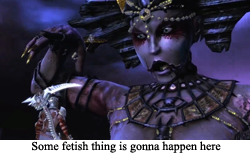Let us address the many sins of Visceral Games’ Dante’s Inferno. We shall see if absolution is possible.
The Sin of Violence: Dante’s Inferno gets a brutal update
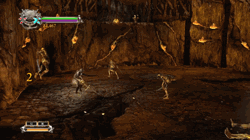 Let’s get the big one out of the way first: who sits down to read Dante Alighieri’s Divine Comedy, and thinks, “Damn! This would make a fine beat ‘em up”? This is something that apparently must have happened, as, here we are, living in a world where Dante ventures forth to tear Hell a new one with a magical scythe. The OG Dante was a poet who wrote his self-insert character into a complicated, but generally mellow, fanfic; this Dante is in a continual state of grating the bones of his enemies across his washboard abs. It is a significantly different interpretation of the same character. And, what’s more, OG Dante’s Inferno is amazingly descriptive in its journey from the underworld to the heavens, but it is also clearly meant as something of an allegory or “imaginary tale” right from the start. Dante was having a dream about his own moral standing in the world! Meanwhile, VG Dante is exactly fighting to save his fiancée and rescue a world threatened by Satan and the unrelenting forces of Hell. Nothing allegorical about pressing X to drive a blade into a sinner’s face!
Let’s get the big one out of the way first: who sits down to read Dante Alighieri’s Divine Comedy, and thinks, “Damn! This would make a fine beat ‘em up”? This is something that apparently must have happened, as, here we are, living in a world where Dante ventures forth to tear Hell a new one with a magical scythe. The OG Dante was a poet who wrote his self-insert character into a complicated, but generally mellow, fanfic; this Dante is in a continual state of grating the bones of his enemies across his washboard abs. It is a significantly different interpretation of the same character. And, what’s more, OG Dante’s Inferno is amazingly descriptive in its journey from the underworld to the heavens, but it is also clearly meant as something of an allegory or “imaginary tale” right from the start. Dante was having a dream about his own moral standing in the world! Meanwhile, VG Dante is exactly fighting to save his fiancée and rescue a world threatened by Satan and the unrelenting forces of Hell. Nothing allegorical about pressing X to drive a blade into a sinner’s face!
Excuse me. I’m getting ahead of myself. My own prejudices against PS2/PS3-style “mature” games are shining through here, and I apologize for dismissing Dante’s Inferno for being a reimagining that was beholden to (then) modern videogame trends. This is unfair, as Real Dante’s Inferno likely survived to the present day entirely because it was contemporary. It was an epic poem, but it was not written in Latin. It involved historical and fictional celebrities that were bumming around various parts of the afterlife. The main character was the prototypical everyman hanging with a trendy historical figure. Complete with more name-dropping than a Kardashian feature, the Divine Comedy was made from its outset to be a popular piece of media, and it is only through centuries and gradually changing standards that it now seems so stiff and religious. I mean, it was always going to be religious as hell with all those popes running around, but popes were basically the Avengers of 1320.
So, alright, VG Dante’s Inferno can be forgiven for going the “popular” route with its interpretation of OG Dante’s Inferno. History has proven that Dante Alighieri clearly would have forsaken all the indie JRPGs of the era to make his story a 3-D action title if he had the technology. But there is still the problem of…
The Sin of Heresy: Dante must cry
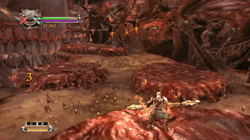 Dante’s Inferno was released for the Playstation 3, Xbox 360, and PSP in 2010. Given the marketing blitz that accompanied the game (“Please visit our E3 booth and be tortured by something other than long lines!”) and the years that have passed since, we will likely never get a real answer on exactly what the designers and marketing department responsible for Dante’s Inferno were thinking. In an obvious way, this deadly Dante screams “this isn’t your daddy’s epic poem,” and lurks around the caverns of Hell doing all sorts of things that could not even be imagined by an epic poet from 690 years prior. This is a videogame from the future, old man, get out of the way and start hammering O to earn salvation!
Dante’s Inferno was released for the Playstation 3, Xbox 360, and PSP in 2010. Given the marketing blitz that accompanied the game (“Please visit our E3 booth and be tortured by something other than long lines!”) and the years that have passed since, we will likely never get a real answer on exactly what the designers and marketing department responsible for Dante’s Inferno were thinking. In an obvious way, this deadly Dante screams “this isn’t your daddy’s epic poem,” and lurks around the caverns of Hell doing all sorts of things that could not even be imagined by an epic poet from 690 years prior. This is a videogame from the future, old man, get out of the way and start hammering O to earn salvation!
On the other hand, Visceral Games’ Dante’s Inferno is inexplicably beholden to the original source material. All of the Circles of Hell are followed precisely according to the source material, despite the fact that figuring out an action-game interpretation of “Level 13: Wood of the Suicides” must have been a pain in the branches. The setting is also firmly rooted in its original epoch, and many of the damned souls that appear across the game are not only seven centuries out of fashion, but also punished for a number of sins we wouldn’t even think about today (“Oh, damned to the circle of violence for… being gay? Really?”). It would have been wholly in the spirit of Dante’s Inferno to update Hell for the modern damned (“Do you punish for forgive this prominent ex-president that may or may not have started a hostage crisis to further his political career?”), or at least drop in period-appropriate fictional characters that are more familiar to modern audiences (not like Dante was doing anything but biting on myths about Helen of Troy anyway), but, nope, you get to make measured choices about Emperor Frederick II. You know! Emperor Frederick II! From all those movies!
And then there are all the little “flourishes” to remind you of the original poem. Game over screens drop annotated passages after every death (and there are quite a few before you see a repeat… assuming you don’t die every seven seconds). Virgil makes absolutely no sense as a character, but stops by to offer his (sometimes literally) same advice and narration as in the original work. And, if you need to answer the question of “what is the absolute worst way to experience a piece of literature”, you can read the entirety of this third of the Divine Comedy via a saved file on your Dante’s Inferno disc. Press L1 to scroll the text faster!
But this, too, could be forgiven. It is cynical to interpret all of these choices as some bizarre, aborted attempt at tying a videogame into school curriculums or college literary programs. Maybe the designers just loved the source material, and wanted to expose the unwashed masses to some culture. Maybe all of these attempts to cram more epic poetry into an epic game was wholly altruistic.
Though that would raise questions about tone…
The Sin of Fraud: Is this supposed to be serious?
 So it is God of War, but instead of Greek/Roman mythology, it is Christian mythology (and, to be clear, I am a Christian, and I can tell you that 99% of Dante’s writings do not appear in the Bible, so “mythology” is the best way to designate this imagining of Hell). And the God of War franchise is known for being equally deadly serious about deicide or Icarus tripping down a hole. It is almost funny how Kratos responds to literally everything from enemy warriors to a dude trapped in a box with “this person must die”, but that is just who Kratos (circa 2010) is as a person. He lives in a serious, violent world, and he has serious, violent solutions to problems.
So it is God of War, but instead of Greek/Roman mythology, it is Christian mythology (and, to be clear, I am a Christian, and I can tell you that 99% of Dante’s writings do not appear in the Bible, so “mythology” is the best way to designate this imagining of Hell). And the God of War franchise is known for being equally deadly serious about deicide or Icarus tripping down a hole. It is almost funny how Kratos responds to literally everything from enemy warriors to a dude trapped in a box with “this person must die”, but that is just who Kratos (circa 2010) is as a person. He lives in a serious, violent world, and he has serious, violent solutions to problems.
And then there’s Dante. Dante fights babies.
Dante’s Inferno has an amazing, unique bestiary with delightfully grotesque monsters symbolizing the various sins. There are also the unbaptized babies of limbo, which are literally just toddlers with swords for arms. And, since babies are not generally known for their threat level, you often fight many of the little tykes at once, prompting bizarre fights wherein you are viciously reaping widdle cutiepies. It is… a choice, and, while the grim and focused start of Dante’s Inferno tells you that this is supposed to be a tale of serious betrayal and heartbreaking consequences, the fact that you are slaughtering babies shortly thereafter undercuts the narrative. Earning the “bad nanny” achievement for “Kill(ing) 20 Unbaptized Children” is something that leaves an impression, too.
And, lest you think we are merely focusing on one ill-advised enemy, there are plenty of moments in Dante’s Inferno that turn hell into a circus (though, in case you are wondering, all clowns do go to Hell). The choice of torturing or absolving sinners is a constant struggle throughout this adventure, and, while torturing prompts a quick and gory cutscene, the road to salvation involves an unusual rhythm game that is shockingly reminiscent of Gitaroo Man. Then you have the fact that Hell is apparently littered with enough collectibles to make a bird ‘n bear proud, complete with happy little messages every time you find Tristan’s Desire or complete a challenge or whatever. Oh, and every goddamned person Dante has ever met in his life has apparently been damned to Hell, so get ready for the most family-reunion-based journey into darkness you could ever imagine.
And, individually, any one of these transgressions against sincerity would not impact the narrative. But when they all combine, they form an unstoppable Voltron of silliness that threatens to blazing sword any shred of dignity in Dante’s world to pieces. You can have a story about a disgraced knight fighting his way through Hell to save the world, but you cannot involve this many angry babies in the proceedings and expect it to be taken seriously.
But being silly should not be a sin. A sin should be something like…
The Sin of Sloth: This Hell is Tedious
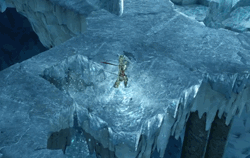 Writing in a contemporary vernacular is often cited as a prime reason Dante’s Divine Comedy has endured through the ages, but it is likely there is another, more obvious reason people have been reading The Inferno for so long: it is friggen fun. For being a tale of woe and suffering, it is enjoyable to see all the ironic punishments that Dante has imagined for the various sinners of the ages. In an unusual way, when you consider the number of “celebrity” sentences involved in the Inferno, Dante’s Inferno could have and likely did read as a revenge tale in its day. Did not like that one Emperor that overtaxed your grandpa? Well now he’s rutting about in poop for the rest of eternity! That’s what you get, loser! And that kind of thing persists into the modern era, because the concept of your landlord forever being tortured by Lucifer’s freezing wings is everlasting.
Writing in a contemporary vernacular is often cited as a prime reason Dante’s Divine Comedy has endured through the ages, but it is likely there is another, more obvious reason people have been reading The Inferno for so long: it is friggen fun. For being a tale of woe and suffering, it is enjoyable to see all the ironic punishments that Dante has imagined for the various sinners of the ages. In an unusual way, when you consider the number of “celebrity” sentences involved in the Inferno, Dante’s Inferno could have and likely did read as a revenge tale in its day. Did not like that one Emperor that overtaxed your grandpa? Well now he’s rutting about in poop for the rest of eternity! That’s what you get, loser! And that kind of thing persists into the modern era, because the concept of your landlord forever being tortured by Lucifer’s freezing wings is everlasting.
Gamer Dante’s Inferno is less everlasting, though. In defense of the game, there is a consistent, intimidating art style, and the monsters you fight across Hell are a lot more unique and diverse than your average beat ‘em up of the same three guys (or an army of the same shadow people). But sometime around when you explode your twelfth super fat puking guy, you realize that there is not much there there. This has a very American McGee’s Alice or McFarlane Toys Reimagining vibe to it, as everything has been reimagined to be broadly edgier… but that’s about all they got. Once you get past Dante’s bizarre fashion choices and slaughtered a baby or two, you realize that the best they will ever be able to do with the final boss is toss a few extra pentagrams into the proceeding. And once you do come to that realization, Hell becomes boring. There is a palpable tedium to seeing “shocking” items over and over, and it really does not help when those same outrageous opponents start looping endlessly during the finale.
And abandon all hope ye who believe the gameplay will save this adventure. That dreariness is locked in practically from the start, with the only real ability enhancements that significantly impact playstyles being reserved for four distinct points across the journey. Beyond that, you simply have relics and upgrade trees that make insignificant changes to the action (“Stop the presses! The combo meter has an extra two seconds of forgiveness!”), and the action is only ever “it’s God of War”. There were already, like, a bunch of God of War games before Dante’s Inferno hit the Playstation, guys! And the PSP does too count!
Look, when your Hell is defined by its monotony, you are committing a mortal sin. But even that sin is nothing before…
The Sin of Lust: Forsaken Beatrice
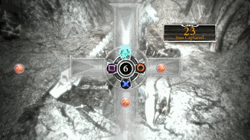 This Dante is not a poet or everyman. This Dante is specifically a knight of the Crusades. This Dante is a man that was deceived by The Church, and was told that his sins would be absolved if he was a good little soldier. When he died, he found he was damned, so he fought back against Death, stole his scythe, and then decided to fight to redeem his myriad sins (though you have to wonder how super damned you would be after literally killing the anthropomorphism of a cosmic rule). Unfortunately, he was dragged to Hell when he returned home and found his father and fiancée were both killed in his absence. Now the soul of said fiancée is in the hands of Lucifer (also his father, but nobody cares about that jerk). Dante dives into the pit to rescue Beatrice, and save us all from Satan along the way.
This Dante is not a poet or everyman. This Dante is specifically a knight of the Crusades. This Dante is a man that was deceived by The Church, and was told that his sins would be absolved if he was a good little soldier. When he died, he found he was damned, so he fought back against Death, stole his scythe, and then decided to fight to redeem his myriad sins (though you have to wonder how super damned you would be after literally killing the anthropomorphism of a cosmic rule). Unfortunately, he was dragged to Hell when he returned home and found his father and fiancée were both killed in his absence. Now the soul of said fiancée is in the hands of Lucifer (also his father, but nobody cares about that jerk). Dante dives into the pit to rescue Beatrice, and save us all from Satan along the way.
So before we go any further in this sad tale, let us examine the original Divine Comedy’s Beatrice. To be clear, in reality, Beatrice was not ever Dante’s wife, and was merely a nine year old girl who made a significant impression on ol’ Dante when he was also nine (if this sounds ridiculous, please consider that this whole scenario apparently worked for Darth Vader). Beatrice was a real person first, and never a lover. In the context of the Divine Comedy, Fictional Beatrice basically steals the chronicler role from Virgil when Dante hits Heaven, because Virgil isn’t allowed past purgatory. But don’t worry, Beatrice is more than a replacement Navi, as while Virgil is the eternal symbol of man’s intelligence and reason, Beatrice is meant to represent the divine, and the holiness of the humanities and man’s general impulses towards art. Yes, it is a bit of a cliché that a poet would consider poetry to be sacred, but you must give Dante a break, as you are someone reading these words on a gorram videogame blog. Beyond all that, though, Beatrice is certainly an unattainable beauty to Dante, but she is also literally the most helpful person in Heaven. That says a lot about the measure of the woman that is the celestial Beatrice.
In Dante’s Inferno for the Playstation 3 and Xbox 360, Beatrice open mouth kisses Satan. For a while.

That looks vaguely uncomfortable for a woman that avoided the male gaze a few centuries back by simply being described as having fair skin and emerald eyes.
Once again, if you squint, you can almost see how this story was created. Dante is an unrepentantly (okay, not technically true) violent man that is irredeemable (again, the whole point is…) in his many murderous actions, so it is easy to see how he needed something “pure” to fight for to endear himself to the player. So if rescuing a princess worked for Link, let’s apply it to another knight. Unfortunately, that immediately delves into the “women as objects” trope, so someone likely thought it would be a good idea to give Beatrice some of her own agency. So no longer is Beatrice simply being damned by Dante’s actions, now she is a woman that chose to go the evil route with Lucifer as her new groom. Apparently selecting Hell in the stratum of the mortal sin of lust is… well, no two ways about it, you’re gonna turn into a whore. Like, literally, complete with pinup transformation and a whole lot of necking. And then, of course Dante has to rescue his former bride from the clutches of almost certainly kinky sex with the Prince of Darkness, because, dang, wouldn’t Dante feel bad if he went through all of this nonsense, and he didn’t win a sexy lady out of the deal?
And, hell, that’s terrible.
Just like the rest of Dante’s Inferno.
Yeah, let’s go ahead and damn Visceral Games’ Dante’s Inferno for all eternity. Some sins are beyond forgiveness.
FGC #603 Dante’s Inferno
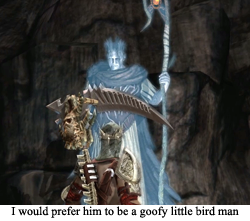 System: Playstation 3, Xbox 360, and PSP. The Playstation 3 version was used for this review, and the PSP is clearly some kind of mad dream of a deranged, damned king.
System: Playstation 3, Xbox 360, and PSP. The Playstation 3 version was used for this review, and the PSP is clearly some kind of mad dream of a deranged, damned king.- Number of players: Virgil would have been the obvious second player, but no dice there. Just Dante.
- Pick your poison: In other games, Classic Mode implies the greatest challenge. Here, apparently, “classic” is meant to denote “based on a literary classic that does not involve buttons”, so Classic Mode is 100% easy mode. You can switch at any time, too, so maybe “practically invincible” mode can come in handy once in a while.
- Eat the baby: Dante’s Inferno was released during that era where every game had to have a superficial morality system (thank you very much, Bioshock). Thus, you continually have the option of punishing or absolving sinners and/or demons. And, much like in many games of the era, absolving appears to always be the proper answer, as you continually gain more “holy bullets” and experience points from showing mercy. I appreciate the moral, but it is yet another example of Dante’s Inferno going about 30% into an interesting idea before immediately giving up.
- Speaking of Morality: Okay, so the sin that damns Beatrice in the first place is that Dante forsook the vow he made before God to never make love to another woman. And why did he do that? Well, because an “enemy” woman begged for her brother’s life to be spared, and Dante satisfied this request for the nookie. But! The saved soldier was not her brother! He was her husband! And said husband then spent the remainder of his life tracking down Dante’s family, and then killing his father and Beatrice! And what are we supposed to take from that? Mercy leads to more violence? Sinning in the name of kindness leads to more sins? Sex equals homicide? Murderers are always gonna murder? Going to be a while before I unpack that one.
- Plot Twist: At the finale of the adventure, Lucifer reveals that the gigantic chains Dante/you have randomly severed throughout Hell were actually the only things holding ol’ Scratch back. This would have been a much bigger surprise if you couldn’t hear Satan laugh maniacally every single time you cut a chain. Dude just has zero poker face.
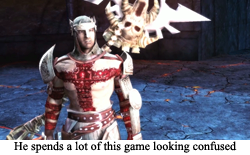 Downloadable Content: There were eventually legitimate expansions to Dante’s Inferno that offer a prelude (based on the poem, and involves werewolves) and an additional playable character (Dante’s guardian angel in the flesh). But right there from launch were purchasable “experience points” to kit out Dante with new moves faster for a few bucks. This is likely why the save file for Dante’s Inferno is locked against copying, because what is player autonomy in the face of potential DLC sales?
Downloadable Content: There were eventually legitimate expansions to Dante’s Inferno that offer a prelude (based on the poem, and involves werewolves) and an additional playable character (Dante’s guardian angel in the flesh). But right there from launch were purchasable “experience points” to kit out Dante with new moves faster for a few bucks. This is likely why the save file for Dante’s Inferno is locked against copying, because what is player autonomy in the face of potential DLC sales?- Watch along: Dante apparently stitched his own cross onto his chest, and that iconic quilt offers animated vignettes about Dante’s various sins. This… is actually kind of cool, even if it does raise more than a few questions about Dante’s apparently enormous embroidery skills. Less cool is that there was an animated tie-in film that corralled some pretty big name creators in the name of Dante’s Inferno: The Anime. Dante’s Inferno: An Animated Epic seems to maintain the general visuals of its source game, but dodges some pretty important plot beats, like Dante conquering the Grim Reaper and stealing his signature weapon. And given it was Direct-to-DVD, watching it through traditional means may be all but impossible now. Maybe Dante could sew a recap blanket for you.
- Did you know? They motion-captured an actual toddler to get realistic baby motions for the murder-infants. The designers were so proud of this, they made a featurette about it that only unlocks after completing the game. Learning more about child monsters is your reward for trudging through Hell. That has to be a sin, too, right?
- Would I play again: I was very happy to see this disc leave my Playstation 3. I played the silly Dante game, Lord, do You want me to suffer again?
What’s next? Random ROB has chosen… Castlevania: Harmony of Dissonance! It just wouldn’t be October without a trip to Castlevania! Please look forward to it!
